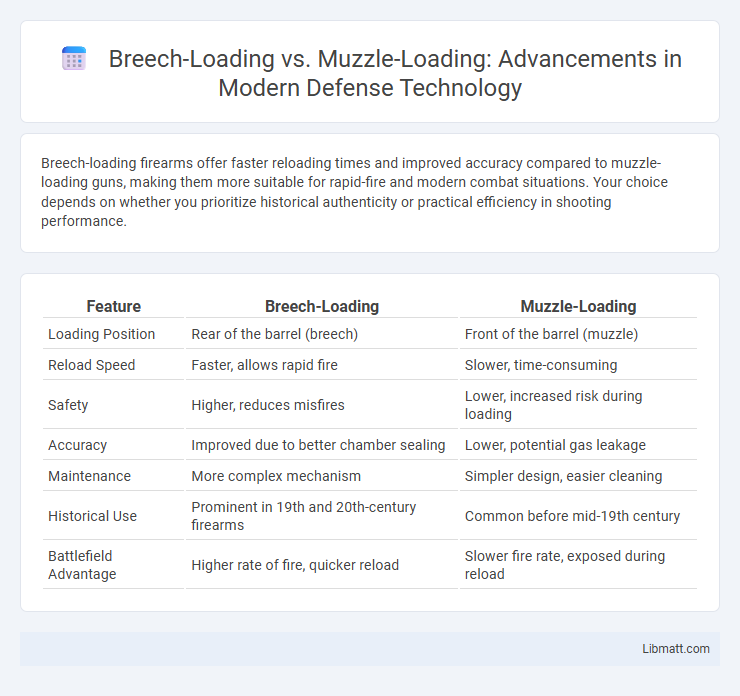Breech-loading firearms offer faster reloading times and improved accuracy compared to muzzle-loading guns, making them more suitable for rapid-fire and modern combat situations. Your choice depends on whether you prioritize historical authenticity or practical efficiency in shooting performance.
Table of Comparison
| Feature | Breech-Loading | Muzzle-Loading |
|---|---|---|
| Loading Position | Rear of the barrel (breech) | Front of the barrel (muzzle) |
| Reload Speed | Faster, allows rapid fire | Slower, time-consuming |
| Safety | Higher, reduces misfires | Lower, increased risk during loading |
| Accuracy | Improved due to better chamber sealing | Lower, potential gas leakage |
| Maintenance | More complex mechanism | Simpler design, easier cleaning |
| Historical Use | Prominent in 19th and 20th-century firearms | Common before mid-19th century |
| Battlefield Advantage | Higher rate of fire, quicker reload | Slower fire rate, exposed during reload |
Introduction: Understanding Firearm Loading Mechanisms
Breech-loading firearms load ammunition directly into the rear of the barrel, enabling faster reloading and improved accuracy compared to muzzle-loading guns, which require loading from the barrel's front. The breech-loading mechanism enhances your shooting efficiency by reducing reload time and minimizing exposure during use. This advancement significantly impacted military tactics and hunting practices by increasing firing speed and ease of operation.
Historical Overview of Breech-Loading and Muzzle-Loading
Breech-loading firearms emerged prominently during the mid-19th century, revolutionizing weaponry by allowing cartridges to be loaded at the rear of the barrel, significantly increasing reload speed and battlefield efficiency. Muzzle-loading weapons, dominant from the 16th to early 19th centuries, required loading powder and projectile from the barrel's front, a slower and more cumbersome process that limited rate of fire. The transition from muzzle-loading to breech-loading marked a pivotal advancement in military technology, influencing tactics and weapon design through faster firing and greater reliability.
Design and Engineering Differences
Breech-loading firearms feature a rear-loading mechanism allowing cartridges to be inserted directly into the chamber, resulting in faster reload times and improved safety compared to muzzle-loaders, which require loading powder and projectile from the barrel's open end. The engineering of breech-loaders incorporates more complex locking systems, such as rotating bolts or sliding blocks, to withstand higher pressures, while muzzle-loaders rely on simpler designs with manual ignition methods like flintlocks or percussion caps. You benefit from breech-loading designs through enhanced accuracy, greater fire rate, and easier maintenance due to advancements in metallurgy and machining precision.
Loading Procedures: Step-by-Step Comparison
Breech-loading firearms feature a rear-loading mechanism allowing you to insert ammunition directly into the breech, significantly reducing reloading time through simplified steps: opening the breech, inserting the cartridge, and closing the breech for firing. Conversely, muzzle-loading requires loading powder, wadding, and projectile sequentially from the barrel's front, demanding meticulous measuring and tamping to ensure proper seating and safety. This fundamental difference in loading procedures results in breech-loaders offering faster and more efficient operation compared to the slower, labor-intensive process characteristic of muzzle-loaders.
Rate of Fire: Efficiency and Speed
Breech-loading firearms significantly outperform muzzle-loading models in rate of fire, allowing faster, more efficient reloading as cartridges are loaded directly into the rear of the barrel. This rapid reload capability enhances your overall firing speed, critical in both historical battles and modern shooting sports. Muzzle-loading weapons require manual loading from the barrel's front, which is slower and more cumbersome, reducing firing efficiency.
Accuracy and Reliability Considerations
Breech-loading firearms offer superior accuracy due to quicker and more consistent loading, minimizing barrel fouling and allowing shooters to maintain better sight alignment. Their design enhances reliability by reducing exposure to dirt and debris, which often compromises muzzle-loading weapons during the loading process. Muzzle-loading firearms, while simpler, require more careful handling and cleaning to sustain accuracy and are typically slower to reload, increasing chances of misfires under demanding conditions.
Safety and Handling Practices
Breech-loading firearms offer enhanced safety by minimizing exposure to the barrel's rear, reducing the risk of accidental discharge during loading. Their design allows for quicker, more controlled loading and unloading processes, promoting safer handling compared to muzzle-loading firearms that require inserting ammunition from the front, which can be cumbersome and increase misfire risks. Proper maintenance and adherence to safety protocols remain crucial for both types to prevent accidents and ensure reliable operation.
Impact on Military Tactics and Warfare
Breech-loading firearms revolutionized military tactics by enabling faster reload times, allowing soldiers to maintain continuous fire and increasing battlefield mobility compared to traditional muzzle-loading weapons. This technological shift facilitated the development of new infantry formations and strategies, such as skirmish lines and rapid volley fire, significantly enhancing combat effectiveness. The increased rate of fire and reliability of breech-loaders diminished the dominance of massed formations, contributing to more dispersed and flexible battlefield tactics during warfare.
Evolution and Technological Advancements
Breech-loading firearms revolutionized weaponry by enabling faster reload times and improved safety compared to traditional muzzle-loading designs. The evolution from muzzle-loading, which required manual loading from the barrel's front, to breech-loading chambers allowed for metallic cartridges and better sealing mechanisms, significantly enhancing firing reliability and accuracy. Your understanding of these technological advancements highlights the transition that shaped modern firearms and battlefield tactics.
Modern Applications and Collectors’ Perspectives
Breech-loading firearms dominate modern military and hunting applications due to their faster reload times and improved safety compared to muzzle-loading guns, which are mostly used today for historical reenactments and by traditional hunting enthusiasts. Collectors value muzzle-loading firearms for their craftsmanship and historical significance, often preserving them as rare, antique pieces, while breech-loaders are prized for technological advancements and reliability. Your appreciation of these weapons depends on whether you prioritize historical authenticity or practical modern use.
breech-loading vs muzzle-loading Infographic

 libmatt.com
libmatt.com